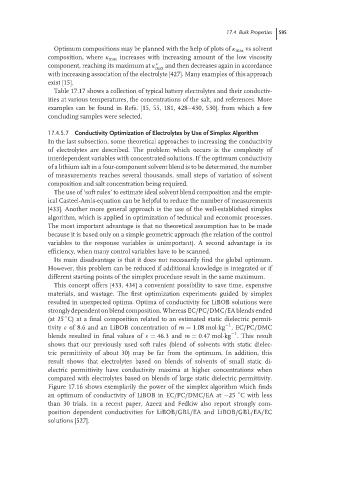Page 621 - Handbook of Battery Materials
P. 621
17.4 Bulk Properties 595
Optimum compositions may be planned with the help of plots of κ max vs solvent
composition, where κ max increases with increasing amount of the low viscosity
component, reaching its maximum at κ max and then decreases again in accordance
∗
with increasing association of the electrolyte [427]. Many examples of this approach
exist [15].
Table 17.17 shows a collection of typical battery electrolytes and their conductiv-
ities at various temperatures, the concentrations of the salt, and references. More
examples can be found in Refs. [15, 55, 181, 428–430, 530], from which a few
concluding samples were selected.
17.4.5.7 Conductivity Optimization of Electrolytes by Use of Simplex Algorithm
In the last subsection, some theoretical approaches to increasing the conductivity
of electrolytes are described. The problem which occurs is the complexity of
interdependent variables with concentrated solutions. If the optimum conductivity
of a lithium salt in a four-component solvent blend is to be determined, the number
of measurements reaches several thousands, small steps of variation of solvent
composition and salt concentration being required.
The use of ‘soft rules’ to estimate ideal solvent blend composition and the empir-
ical Casteel-Amis-equation can be helpful to reduce the number of measurements
[433]. Another more general approach is the use of the well-established simplex
algorithm, which is applied in optimization of technical and economic processes.
The most important advantage is that no theoretical assumption has to be made
because it is based only on a simple geometric approach (the relation of the control
variables to the response variables is unimportant). A second advantage is its
efficiency, when many control variables have to be scanned.
Its main disadvantage is that it does not necessarily find the global optimum.
However, this problem can be reduced if additional knowledge is integrated or if
different starting points of the simplex procedure result in the same maximum.
This concept offers [433, 434] a convenient possibility to save time, expensive
materials, and wastage. The first optimization experiments guided by simplex
resulted in unexpected optima. Optima of conductivity for LiBOB solutions were
strongly dependent on blend composition. Whereas EC/PC/DMC/EA blends ended
◦
(at 25 C) at a final composition related to an estimated static dielectric permit-
−1
tivity ε of 8.6 and an LiBOB concentration of m = 1.08 mol·kg , EC/PC/DMC
−1
blends resulted in final values of ε = 46.3and m = 0.47 mol·kg . This result
shows that our previously used soft rules (blend of solvents with static dielec-
tric permittivity of about 30) may be far from the optimum. In addition, this
result shows that electrolytes based on blends of solvents of small static di-
electric permittivity have conductivity maxima at higher concentrations when
compared with electrolytes based on blends of large static dielectric permittivity.
Figure 17.16 shows exemplarily the power of the simplex algorithm which finds
◦
an optimum of conductivity of LiBOB in EC/PC/DMC/EA at −25 C with less
than 30 trials. In a recent paper, Azeez and Fedkiw also report strongly com-
position dependent conductivities for LiBOB/GBL/EA and LiBOB/GBL/EA/EC
solutions [527].

